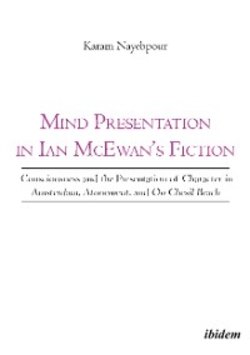Читать книгу Mind Presentation in Ian McEwan's Fiction - Karam Nayebpour - Страница 9
1.2 Mind Representation in Amsterdam, Atonement and
On Chesil Beach and the Aim of this Study
ОглавлениеPresentation of the characters' mental functioning is the central narrative concern in McEwan's AM, AT and CB. In the first part of AT Briony, is represented as yearning to impose her mental order on her surroundings. Likewise, McEwan's two other narratives, as Wells states, »have a number of things in common despite their very different subjects and generic styles. Both focus on a small number of characters engaged in tightly formed relationships and lead to intense dramatic action and climactic endings« (Ian McEwan 84). This study maintains that whenever the main characters in the chosen narratives become too much intramental pursuing only their own interests or perspectives, they finally face excruciating pain and failure. Although the fictional minds in AM are situated and constructed socially, the communication among them fails mostly because the intramental side of their mental functioning overcomes the intermental one or the balance between them is disrupted. The reader mainly becomes aware of such situations through both the narrative presentation of the concerned characters' unuttered thoughts and their behaviour. For example, in AM, »As the novel proceeds, the reader enters the minds of the two protagonists and some other characters, too, and follows their moods, uncertainties, and intimations of mortality and immortality« (Malcolm 192). In other words, »In both books, the characters are either unwilling or unable to recognise the needs of others, and remain trapped within modes of self-serving behaviour that ultimately harm them as well« (Wells, Ian McEwan 85). Moreover, the primary focus of these narratives seems to be character presentation. According to Palmer »characters« in these narratives »face sharp and painful dilemmas relating to attempts to exercise control over other minds and the motives in trying to doing so« (Social 64). This characteristic, presentation of characters' or selves' relationships with the others, is in fact in line with McEwan's style too. Pascal Nicklas refers to this case stating that: »At the heart of McEwan's poetology is the desire to look through the eyes of someone else. The confusion of the self and the other [. . .] in general opens up for Ian McEwan the ethical dimension of literature« (9). Further, the main problem in these narratives arises when the rift between the central characters' intermental units and their intramental orientations is left unfilled causing disequilibrium in the narratives. This brings about a situation when the central characters are unable to come to terms with their own problems or, recognizing them, they are unable to cure them through having a real affiliation between their private selves and the social cognitive networks. In other words, they are unable to construct a permanent balance in their intermental units. It is mainly because of such paucity that their relationships are likely affected adversely.
This study explores the mental functioning of the central characters in McEwan's three narratives. As it is shown in the discussion chapters, the main reason for the disruption of fictional intermental units in AM, AT and CB appears to be the central characters' intramental dissents. The possible worlds in these narratives, moreover, anchor themselves strongly to the reader's world knowledge, experiences or models. This happens because the narratives primarily represent the impact of the presented events and situations on the central characters' consciousness throughout their life courses. This characteristic makes the mentioned narratives more narratives or narratives with high degrees of narrativity because they closely portray the characters' consciousness or the quality of what it's like to undergo some experiences. The difficulty of constructing stable intermental relationships or cognitive units between and among these minds, however, appears to be the main reason for the destructive consequences in these narratives. The »reflector-characters«[9] in these narratives, furthermore, appear to prefer their single subjectivity over (re)constructing intermental units. They are depicted as relying mainly on their own (mis)interpretations of the other(s) as well as on their own minds or highly aspectual perceptions. That seems to be the fundamental reason in bringing about the lack of a unified social or intermental unit in these narratives or annihilating any established one(s) within them.
As this study argues, the workings of the fictional minds in AM, AT and CB reveal both intermental/social and intramental/individual aspects. It is, nevertheless, the negative emotional consequences of their subjective first position, or intramental side of their mental functioning, that fundamentally orient their mental states. This also finally brings about the fatal imbalance to their relationships. In AM, this situation ends at Clive's and Vernon's double murder and in CB in Edward's and Florence's separation before consummating their marriage. This study explores the way(s) fictional minds within these narratives operate when they encounter with challenging conflicts as well as the impact of those momentous conflicts on the operation of their consciousness. Following such a process, the study explores how narrative experience takes place too. To do that, the study, in a combining manner in the discussion chapters, uses the terminologies provided by Palmer and Herman about the workings and presentation of fictional minds as well as the impact of the dissenting events and situations on their experiencing consciousness within AM, AT and CB. Accordingly, two subjects are explored in the theoretical part of this study: the relationship between narrative meaning or experience and fictional minds as well as the connection between any narrative reader's cognitive abilities and her/his understanding of the fictional minds. In analysing the three selected narratives, this study focuses on three points. Firstly, it examines the narrativity level of each narrative. Secondly, it explores the way fictional minds in them are presented and the manner of their operation. Finally, the study analyses the impacts of central characters' thoughts and (mental) experiences on their and the other characters' (individual and social) behaviour/actions as well as relationships.
